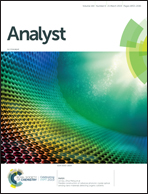Rapid and direct mass spectrometric analysis of antibiotics in seawater samples†
Abstract
A method based on droplet spray ionization (DSI) mass spectrometry was described for rapid, direct analysis of seawater samples. By spontaneous desalting (SD) of droplet seawater on a cover slip corner, the target analytes could be separated from the salts. The separated targets are then dissolved in a spray solvent for mass spectrometric analysis. The desorption/ionization of salts is impeded due to their microsolubility or even insolubility in the spray solvent, thus greatly reducing the suppression of ionization of the analyte. It has been demonstrated that the desalting process is spontaneous and highly effective, which simplifies the operation. The dependence of signal intensity on the operation parameters was investigated as well. With this method, a wide range of antibiotics including sulfonamides, macrolides, amphenicols, quinolones, rifamycins, and mixtures in seawater have been successfully detected in either positive or negative ion modes. Limits of detection (S/N ≥ 3) were determined to be 0.52 and 0.20 pg for trimethoprim and clarithromycin, respectively. Moreover, satisfactory accuracy and precision were obtained according to the analysis of real seawater samples. Our results show that the combination of DSI and spontaneous desalting is a simple, sensitive, and rapid method for direct detection of analytes in seawater.



 Please wait while we load your content...
Please wait while we load your content...